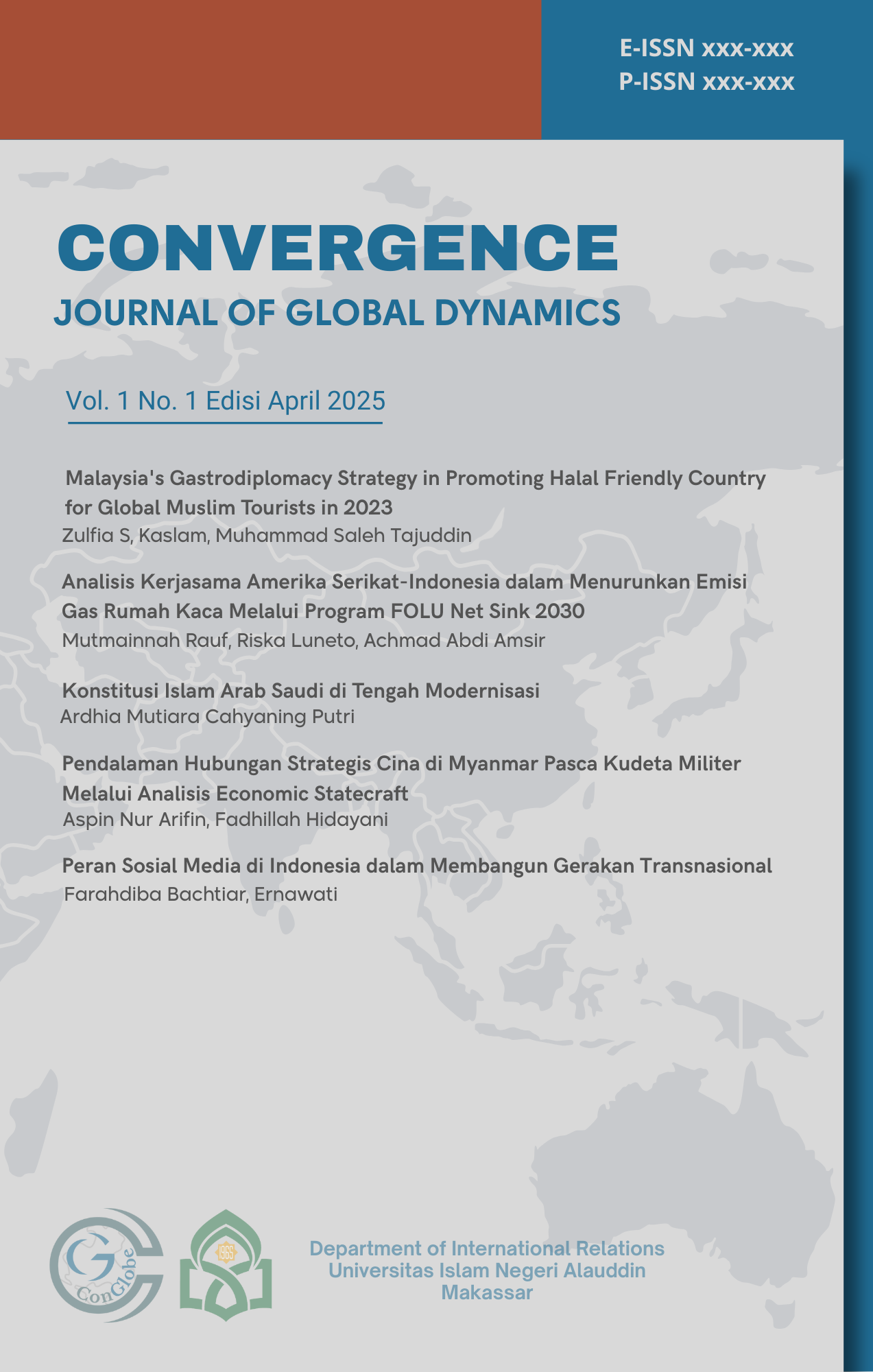Pendalaman Hubungan Strategis Cina di Myanmar Pasca Kudeta Militer Melalui Analisis Economic Statecraft
Keywords:
China–Myanmar relations; economic statecraft; Belt and Road Initiative; state-owned enterprises; infrastructure diplomacy; geopolitical strategy; Southeast AsiaAbstract
This study investigates China's strategic economic engagement with Myanmar after the 2021 military coup, focusing on the deployment of economic statecraft through the Belt and Road Initiative (BRI). The objective is to understand how China's pragmatic approach in foreign economic policy supports its geopolitical interests while consolidating influence in Southeast Asia. A qualitative research method with a case study approach was adopted. Data were collected through document analysis, including official reports, academic literature, and international databases, analyzed using the theoretical framework of economic statecraft to reveal patterns of strategic behavior. Findings show that China has sustained and expanded its economic activities in Myanmar post-coup, maintaining close ties with the military regime through state-owned enterprises (SOEs). Projects like the China-Myanmar Economic Corridor (CMEC), deep-sea ports, rail infrastructure, and mining operations have bolstered China’s strategic access to the Indian Ocean while insulating its interests from Western sanctions. The study reveals China's deliberate orchestration of commercial and diplomatic instruments to align Myanmar’s economic dependency with its broader geopolitical vision, particularly reducing reliance on the Malacca Strait and securing energy routes. China’s use of economic statecraft in Myanmar illustrates a proactive and calculated foreign policy strategy. Through infrastructure diplomacy and the mobilization of SOEs, China secures regional influence while advancing BRI goals. This study contributes to understanding power projection through economic instruments and suggests further research on comparative cases across the Global South.
References
Alauddin, A. (2021, April 9). Kudeta Militer dan Stabilitas Kawasan ASEAN. Retrieved Maret 4, 2024, from CNBC Indonesia: https://www.cnbcindonesia.com/opini/20210409042332-14-236409/kudeta-myanmar-dan-stabilitas-kawasan-asean
Anam, S., & Ristiyani. (2018). Kebijakan Belt and Road Initiative (BRI) Tiongkok Pada Masa Pemerintahan Xi Jinping. Journal Unpar, 11-17.
Anggarawal, V. K., & Reddie, A. W. (2021). Economic Statecraft in the 21st Century: Implication for the Future of the Global Trade Regime . World Trade Review , 138-147.
Atkinson-Grosjean, J., & Fairley, C. (2009). Moral Economies in Science: From Ideal to Pragmatic. Minerva, 167.
Bi, S. (2014). Chapter 7 The Economic Relation of Myanmar-China. Institute of Developing Economies, 179-180.
Blanchard, J.-M. F., & Ripsman, N. M. (2013). Economic Statecraft and Foreign Policy: Sanctions, Incemtives, and Target State Calculation. USA and Canada : Routledge .
Brautigam, D., & Xiaoyang, T. (2012). Economic Statecraft in China's New Overseas Special Economic Zones: Soft Power, Business or Resource Security? International Affairs, 801.
Breslin, S. (2007). China and the Global Political Economy. 131: Palgrave Macmillan.
Cameron, S. (2023, november 22). Why is Myanmar's New Deep-Sea Port Such Hot Property. Retrieved mei 30, 2024, from Lowy Institute: https://www-lowyinstitute-org.translate.goog/the-interpreter/why-myanmar-s-new-deep-sea-port-such-hot-property?_x_tr_sl=en&_x_tr_tl=id&_x_tr_hl=id&_x_tr_pto=tc
Chanda, J. (2021). The China Myanmar Economic Corrior: A Reality Check. National Security, 4(3), 275-276.
China Global Newsletter. (2023, Mei 8). Chinese Investment in Myanmar After the Coup . Retrieved Maret 9, 2024, from Inclusive Development International: https://www.inclusivedevelopment.net/china-global-program/china-global-newsletter-eition-8/
China Railway Eryuan Engineering Group (CREEC). (2014). China Railway Eryuan Engineering Group (CREEC). Retrieved from Devex World 2024: https://www.devex.com/organizations/china-railway-eryuan-engineering-group-creec-39956
CITIC Group. (2022). CITIC Group Quotes. Retrieved juni 7, 2024, from group.citic: https://www.group.citic/en/#lastPage
CITIC Limited . (2020). About Us. Retrieved juni 7, 2024, from citic.com: https://www.citic.com/en/aboutus/history/
CMEC. (2016). China Machinery Engineering Corporation. cmec.com.
Dean, K. (2022). Infrastructures and B/ordering: How Chinese Projects are Ordering China-Myanmar Border Spaces . Regional Studies Association, 9-10.
Demir, A. (2023). The Effect of China: The BRI Project in Myanmar. Frequency of International Relation, 4(2), 140-141.
Eleven Media Group. (2020, februari 16). First phase of Kyaukphyu Deep Seaport project expected to cost $1.3 bln. Retrieved mei 30, 2024, from Eleven Media Group: https://elevenmyanmar.com/news/first-phase-of-kyaukphyu-deep-seaport-project-expected-to-cost-13-bln
Ferchen, M., & Mattlin, M. (2023). Five Modes of China's Economic Infuence: Rethinking Chnese Economic Statecraft. Taylor & Francis Group, 36(5), 979-989.
Fiantika, F. R. (2022). Metodologi Penelitian Kualitatif . PT. Global Eksekutif Teknologi, 1.
Ford, M., Gillan, M., & Thein, H. H. (2024). Political Regimes and Economic Policy. Routledge, 114-119.
Glendinning, A. (2023, Juni 27). Myanmar's Economic Recovery Slowed by High Prices and Shortages. Retrieved April 14, 2024, from The World bank: https://www.worldbank.org/en/news/press-release/2023/06/25/myanmar-s-economic-recovery-slowed-by-high-prices-and-shortages
Goh, E., & Steinberg, D. I. (2016). Steinberg, 3 Myanmar’s Management of China Influence: From Mutual Benefit to Mutual Dependence, Rising China’s Influence in Developing Asia. Oxford University Press, 55.
Hameiri, S., & Jones, L. (2016). Rising Power and State Transformation: The Case of China . Journal of International Relations, 77.
Hameiti, S., & Jones, L. (2015). Global Governance as State Transformation. Political Studies , 3.
Henisz, W. J., & Zelner, B. A. (2003). The Stategic Organization of Political Risks and Opportunitie. Strategic Organization, 452.
Hsu, & Munich. (2024, maret 20). Myanmar seeks Chinese funding and design assistance for Muse-Mandalay Railway Project. Retrieved from NP New: https://npnewsmm.com/news/65fa91e99ca8270b7a40b553
Htut, W. (2019, September 20). Myanmar and China sign MoU on Muse-Mandalay Railway Project. Retrieved from Eleven Media Group : , https://elevenmyanmar.com/news/myanmar-and-china-sign-mou-on-muse-mandalay-railway-project
Huaxia. (2020, Jamuari 18). Xi Stresses Importance of China-Myanmar “Paukphaw” Friendship. Retrieved Mei 25, 2024, from Xinhuanet: https://www-xinhuanet-com.translate.goog/english/2020-01/18/c_138714298.htm?_x_tr_sch=http&_x_tr_sl=en&_x_tr_tl=id&_x_tr_hl=id&_x_tr_pto=sc
Informa Markets. (2024). China Machinery Engineering Corporation. Retrieved juni 6, 2024, from Energy & Utilities: https://energy-utilities.com/china-machinery-engineering-corporation-comp292506.html
Ji, Q. (2022). The Social Barrier of Strategic Coupling: A Case Study Letpadaung Copper Mine in Myanmar. Multidisciplinary Digital Publishing Institute (MDPI), 5-6.
Jianing, C. (2018, desember 13). BRI Calls for joint effort by China, Myanmar, Belt and Road Portal . Retrieved from Global Times : https://eng.yidaiyilu.gov.cn/p/74604.html
Jianing, C. (2018, Desember 13). BRI Calls for Joint Efforts by China, Myanmar, Belt and Road Portal . Retrieved Mei 23, 2024, from Global Times : https://eng.yidaiyilu.gov.cn/p/74604.html
Jing, Y. (2017). The Transformation of Chinese Governance: Pragmatism and Incremental Adaption. Fudan University, 37.
Johnston, L. A. (2018). The Belt and Road Initiative: What is in it for China? Wiley Asia & The Pacific Studies , 58.
Jones, L. (2014). Explaining Myanmar's Regime Transition: the Periphery is Central. Taylor & Francis , 787-792.
Jones, L. (2014). The Political Economy of Myanmar's Transition. Journal of Contemparary Asia, 44(1), 148.
Jones, L. (2018). Political Economy. In Routledge Handbook of Contemporary Myanmar (pp. 181-187). New York: Routledge .
Jones, L. (2019). Theorizing Foreign and Security Policy in an Era of State Transformation: A New Framework and Case Study of China. Journal of Global Security Studies , 581.
Jones, L., & Myo, K. M. (2021). Explaining Myanmar's Respons to China's Belt and Road Initiative: From Disengagement to Embrace. Johns Hopkins University Press, 45(2), 317.
Jones, L., & Zeng, J. (2019). Understanding China's 'Belt and Road Initiative': beyond 'Grand Strategy' to a State Transformation Analysis. Taylor and Francis Group, 1-9.
Jones, L., & Zou, Y. (2017). Rethinking the Role of State-owned Enterprises in China's Rise. Taylor & Francis Group, 22(4), 743.
Kironska, K., & Jiang, D. (2023). China-Myanmar Relation after the 1 February Military Coup. ANU Press, 120-121.
Kostecka-Tomaszewska, L., & Krukowska, M. (2021). China's Economic Statecraft: The Role of the Belt and Road Initiatiive. European Research Studies Journal, 24(2), 1026-1027.
Kudo, T. (2006). Myanmar's Economic Relation with China: can China Support the Myanmar Economy? . Institute of Developing Economies , 13.
Kyi, T. K., & Zaisheng, X. (2020). The 21st century Maritime Silk Road and the role of Myanmar. Journal of East China Normal University (Natural Science), 2-3.
Lancang-Mekong Cooperation. (2020, januari 20). The Letpadaung Copper Mine benefits Burmese. Retrieved mei 31, 2024, from Lancang-Mekong Cooperation: http://www.lmcchina.org/eng/2020-01/20/content_41450400.html
Latief, M. N., & Idrus, P. G. (2021, maret 9). Opini: Myanmar dan dinamika hubungannya dengan China . Retrieved April 24, 2024, from Anadolu Agency: https://www.aa.com.tr/id/berita-analisis/opini-myanmar-dan-dinamika-hubungannya-dengan-china/2174006
Linn, S. N. (2023, Januari 24). Myanmar Plunges Deeper Into Economic Crisis. Retrieved April 14, 2024, from East Asia Forum: https://eastasiaforum.org/2023/01/24/myanmar-plunges-deeper-into-economic-crisis/
Millar, T. (2023, februari 1). The China-Myanmar Economic Corridor, 2 Years After the Coup. Retrieved mei 11, 2024, from The Diplomat: https://thediplomat.com/2023/02/the-china-myanmar-economic-corridor-2-years-after-the-coup/
Min, A., & Kudo, T. (2012). Chapter 6 Newly Emerging Industrial Development Nodes in Myanmar: Ports, Roads, Industrial Zones along Economic Corridors. BRC Research Report, 190.
NORINCO. (2014). About NORINCO. Retrieved juni 7, 2024, from http://en.norinco.cn/col/col6486/index.html
Norris, W. J. (2016). Chinese Economic Statecraft: Commercial Actors, Grand Strategy, and State Control. Cornell Univercity Press, 13-14.
Norris, W. J. (2016). Chinese Economic Statecraft: Commercial Actors, Grand Strategy, and State Control. United State of Amerika: Cornell Univercity Press.
O'Connor, J. (2011). State Building, Infrastructure Development and Chinese Energy Projects in Myanmar. Irasec Discussion Papers , 4.
Pei, M. (2006). Assertive Pragmatism: China's Economic Rise and its Impact on Chinese Foreign Policy. Security Studies Department , 9.
Poling, G. B. (2018). Kyaukphyu Connecting to the Indian Ocean. CSIS (Center for Strategic & International Studies , 2.
Ramachandran, S. (2023, Juli 7). China's Collaboration with the Myanmar Junta: A Case of Strategic Hedging? . Retrieved Maret 14, 2024, from The Jamestown Foundation: https://jamestown.org/program/chinas-collaboration-with-the-myanmar-junta-a-case-of-strategic-hedging/
Reilly, J. (2013). China's Economic Statecraft: Turning Wealth Into Power . Lowy Institute For International Policy, 2-5.
Reilly, J. (2021). Crossing Lines: China's Econoic Statecraft in Myanmar. In J. Reilly, Orchestration: China’s Economi Statecraft Across Asia and Europe (pp. 139-151). New York: Oxford University Press.
Reilly, J. (2021). Orchestrating China’s Economic Statecraft, Orchestration: China’s Economi Statecraft Across Asia and Europe. new york: Oxford University Press.
Rivai, A. N. (2022). Kebijakan Ekonomi Luar Negeri China dari Masa ke Masa dan Ambisi Internasionalisasi BUMN China di Tangan Xi Jinping . Jurnal Ilmiah Hubungan Internasional Fajar, 49-67.
Rivai, A. N., & Virgianita, A. (2019). China Controls Business Actors to Implement Belt and Road Initiative as Connectivity Project. International Conference on Strategic and Global Studies , 1-26.
Roberts, P. (2021). Economic Statecraft with Chinese Characteristics: Strange, New, and Different, or Old in New Bottles? Journal of Current Chinese Affairs, 50(3), 271.
Rogers, R. A. (2023). The United States’ Myanmar Policy After The 2021 Military Coup and Its Prospects Under China-US Startegic Competition. Asian Affairs: An American Review , 261-263.
Rusandi, & Rusli, M. (2021). Merancang Penelitian Kualitatif Dasar/Deskriptif dan Studi Kasus. Jurnal STAI DDI Makassar, 2-3.
Sandhi Governance Institute. (2021). Belt and Road Monitoring Project: Letpadaung Copper Mine . BRI Monitor , 5.
Sandhi Governance Institute. (2021). Kyaukphyuk Special Economic Zone. BRI Monitor , 1-4.
Sandi Governance Institute. (2021). The Muse-Mandalay Railway. BRI Monitor , 4-7.
Singh, M. P. (2018, November). CMEC dan Implikasi Strategisnya. Retrieved Juli 18, 2024, from https://egrowfoundation.org/research/cmec-and-its-strategic-implications/
Sithu. (2024, April 26). China’s Engagement with the Myanmar Junta: A High Cost. Retrieved Juni 13, 2024, from Low Returns Deal, Fulcrum Analysis on Southeast ASIA: https://fulcrum.sg/chinas-engagement-with-the-myanmar-junta-a-high-cost-low-returns-deal/
Soong, J.-J., & Aung, K. H. (2020). Myanmar's Perception and Strategy Toward China's BRI Expansion on Three Major Projects Development: Hedging Strategic Framework with State-Market-Society Analysis. The Pacific Review, 54(1), 24.
Sun, D., & Zoubir, Y. (2018). "Development First": China's Invesment in Seaport Constructions and Operations along the Maritime Silk Road. Asian Journal of Middle Eastern and Islamic Studies, 43.
Tessaron. (2023, desember 27). China and Myanmar Sign Deal to Complete Kyaukphyu Deep Sea Port. Retrieved mei 30, 2024, from Atlas News : https://theatlasnews.co/business/2023/12/27/china-and-myanmar-sign-deal-to-complete-kyaukphyu-deep-sea-port/
Tritto, A., & Park, A. (2020). The Belt and Road Initiative in ASEAN. Institute For Emerging Market Studies, 12.
W.Chan, D. S. (2021, September 2). Bussiness as Usual: Chinese Investment After the Myanmar Coup. Retrieved Maret 9, 2024, from Diplomat Media: https://thediplomat-com.translate.goog/2021/09/business-as-usual-chinese-investments-after-the-myanmar-coup/?_x_tr_sl=en&_x_tr_tl=id&_x_tr_hl=id&_x_tr_pto=sc
Wirayudha, R. (2017, september 6). Pura-pura Demi Burma Merdeka . Retrieved from Historia id: https://historia.id/politik/articles/pura-pura-demi-burma-merdeka-D8ewR/page/1
Wong, A. (2019, januari 22). China's Economic Statecraft under Xi Jinping. Retrieved from Brookings: https://www.brookings.edu/articles/chinas-economic-statecraft-under-xi-jinping/
Wulthow, J. (2017). China Strategic Perspectives Chinese Perspectives on the Belt and Road Initiative: Strategic Rationales, Risks, and Implications. National Defense University Press, 8.
Xinhua, & Rahman, M. R. (2023, Mei 3). China dan Myanmar Siap Perdalam Kerja Sama di Berbagai Bidang. Retrieved Mei 1, 2024, from Antara: https://www.antaranews.com/berita/3518730/china-dan-myanmar-siap-perdalam-kerja-sama-di-berbagai-bidang
Yu, K. (2021). The Belt and Road Initiative in Southeast Asia after COVID-19: China’s Energy and Infrastructure Investments in Myanmar. Singapore: ISEAS Perspective .
Yu, P.-H. (2021, maret 23). Letpadaung Copper Mine. Retrieved mei 15, 2024, from The People's Map of Global China: https://thepeoplesmap.net/project/letpadaung-copper-mine




